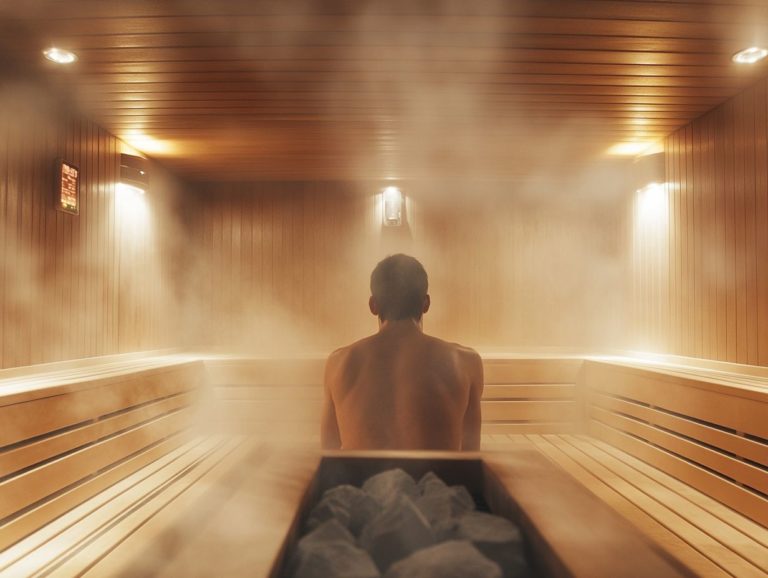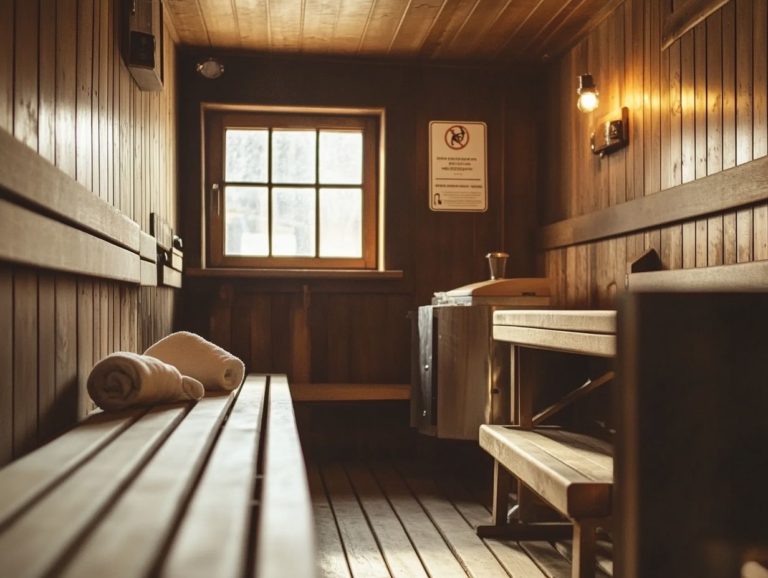Understanding Sauna Safety Policies
Saunas provide a serene escape. It is crucial to familiarize yourself with sauna safety policies to ensure a secure experience.
This article delves into the significance of sauna safety, shedding light on potential risks and dangers that may arise with sauna use. It outlines various sauna safety policies, encompassing facility guidelines and personal precautions you should take to maximize the benefits of sauna bathing.
You ll discover practical tips for maximizing your sauna sessions, including insights into sauna techniques, along with special considerations for children and the elderly.
Dive into this guide and discover how to savor the heat safely and enjoy the numerous sauna benefits!
Contents
- Key Takeaways:
- What are Sauna Safety Policies?
- Importance of Sauna Safety
- Types of Sauna Safety Policies
- Tips for Sauna Users
- Sauna Safety for Children and Elderly
- Frequently Asked Questions
- What are sauna safety policies?
- Why is it important to understand sauna safety policies?
- What are some common sauna safety policies?
- Can sauna safety policies vary from place to place?
- What should I do if I notice someone not following sauna safety policies?
- Are there any consequences for not following sauna safety policies?
Key Takeaways:
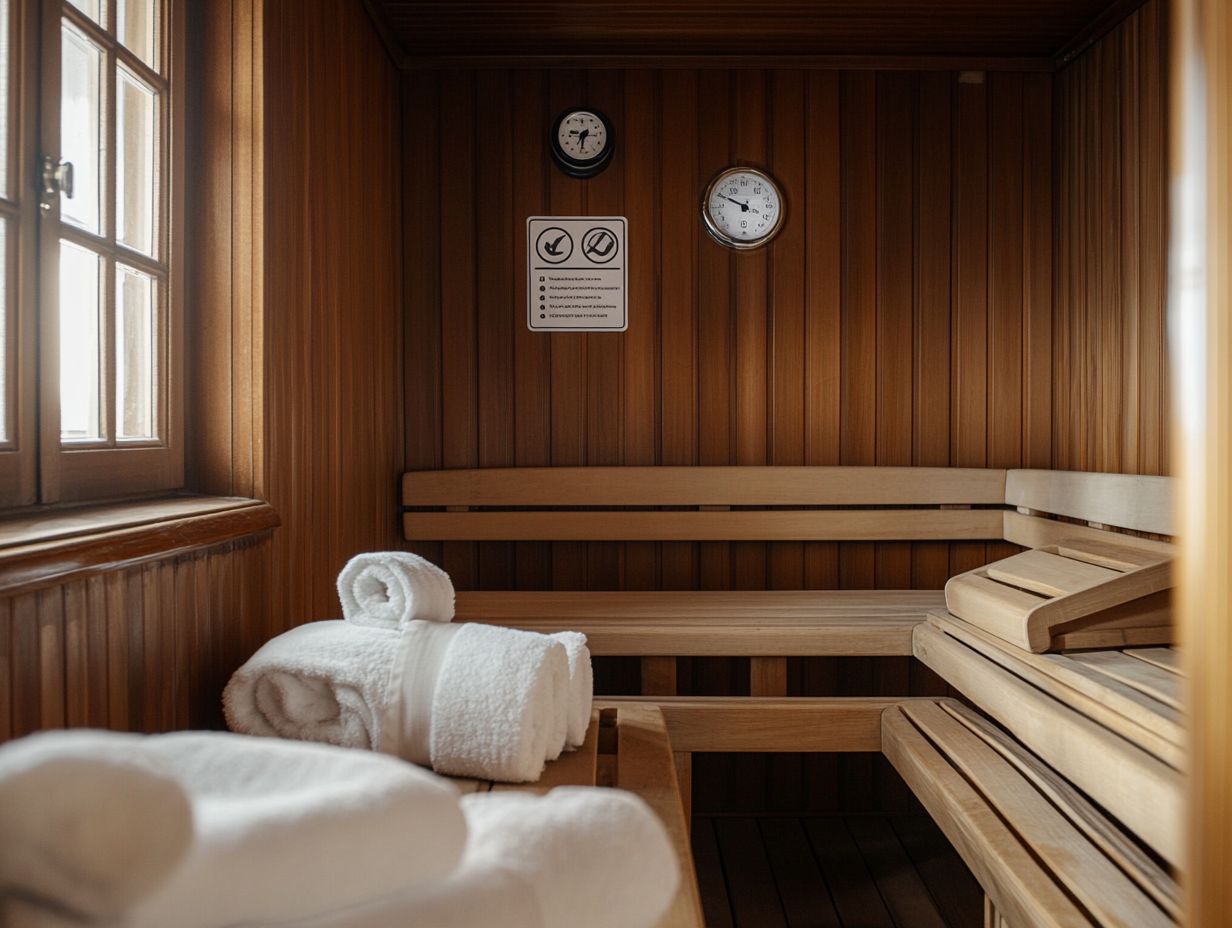
- Sauna safety policies prevent risks associated with sauna use.
- These policies include guidelines and personal safety precautions.
- Extra precautions are important for vulnerable groups like children and the elderly.
What are Sauna Safety Policies?
Sauna safety policies serve as essential guidelines to guarantee a secure and enjoyable experience for you and all users. They cover critical aspects like temperature controls, sauna etiquette, and the impressive health benefits of regular sauna use, including enhanced heart health, relaxation, and improved overall well-being.
These policies not only raise awareness of potential risks but also establish a framework that allows you to engage effectively with various sauna types whether it s a Finnish sauna, Turkish-style sauna, or an infrared sauna while considering any personal health conditions that may influence your sauna experience.
Importance of Sauna Safety
The significance of sauna safety is paramount; improper use can lead to dehydration, overheating, and various health risks that may worsen existing conditions, including an increased risk of cardiovascular disease. Such oversights can undermine the numerous health benefits that saunas are celebrated for.
To fully savor the soothing warmth of a sauna and truly harness its cardiovascular advantages, it s essential to adhere to established safety protocols. Ensure you are well-hydrated before and after your sauna session, limit your time inside to prevent overheating, and be mindful of any personal health conditions that could impact your sauna experience.
By prioritizing these safety measures, you not only shield yourself from potential adverse effects but also cultivate an atmosphere that promotes deep relaxation and improved heart health. Following these guidelines can elevate your overall sauna experience, transforming it into a cherished wellness ritual instead of a source of unnecessary risk.
Potential Risks and Dangers
Using a sauna can come with its share of risks, particularly concerning dehydration and overheating. This is especially true if you have specific health conditions or are unfamiliar with sauna etiquette. It s crucial to recognize your personal limits and be attuned to the critical signs of distress during your sauna sessions.
Being aware of symptoms like dizziness, excessive sweating, or an unusually fast heartbeat is essential for ensuring a safe experience. Remember to hydrate thoroughly before and after your sauna time; your body will thank you for it.
If you have pre-existing health conditions, such as cardiovascular issues or respiratory disorders, it s wise to consult with a healthcare professional before making sauna visits a regular part of your routine. Understanding how your body reacts can help you avoid any adverse effects, allowing you to enjoy the experience even more.
Listening to your body and taking breaks when necessary can greatly enhance your safety while enjoying the soothing benefits of the sauna.
Stay safe and enjoy your sauna experience!
Types of Sauna Safety Policies
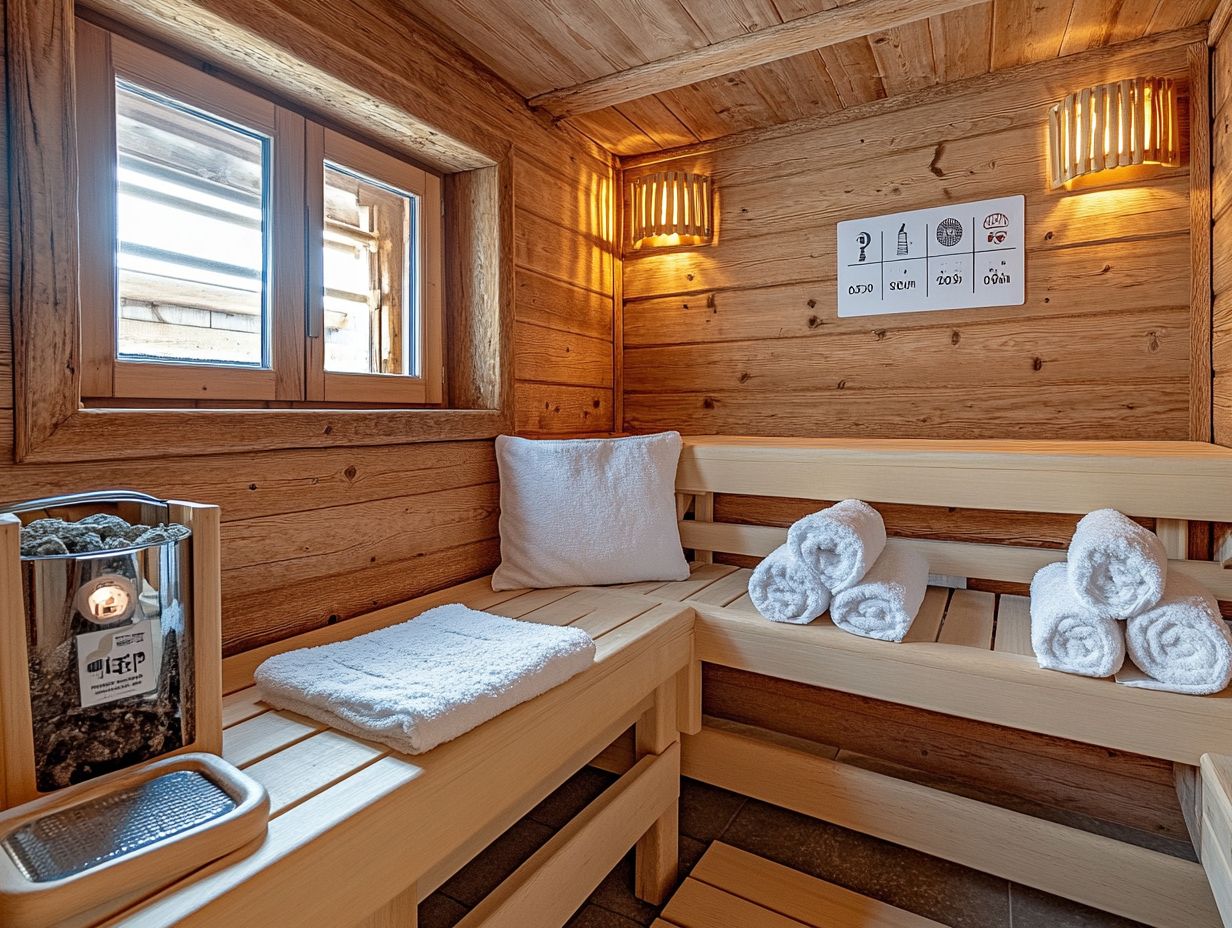
Sauna safety policies can be broadly classified into two categories: facility-specific guidelines and personal safety precautions. These measures are designed to enhance your sauna experience while prioritizing safety.
Following sauna etiquette is crucial for creating a respectful communal environment. This ensures that everyone can enjoy their time in the sauna to the fullest.
Facility Policies and Guidelines
Facility policies are essential for sauna safety. They set the operational standards that create a safe and enjoyable environment for everyone. Make sure to follow temperature guidelines for maintaining a consistent sauna temperature and practicing proper sauna etiquette.
To enhance your sauna experience, familiarize yourself with specific facility policies on cleanliness, maintenance practices, and user capacity. Cleanliness protocols, such as regular disinfection of surfaces, help maintain a hygienic space. Diligent maintenance routines ensure that equipment functions properly, reducing discomfort or hazards. Additionally, understanding sauna safety legislation can further enhance your experience and ensure compliance with safety standards.
Staying within a consistent temperature range is crucial for your comfort and safety. Open communication about sauna etiquette like towel usage and noise levels fosters a more enjoyable atmosphere. To ensure you’re following the best practices, it’s important to understand sauna safety regulations. This allows you to fully enjoy the health benefits of saunas.
Personal Safety Precautions
Personal safety precautions are vital for a safe sauna experience, especially for those with specific health conditions. Follow sauna rules regarding session length, proper hydration, and knowing your limits.
It’s essential to hydrate adequately before and after each sauna session to replenish lost fluids. This is particularly important if you plan to soak up the heat for an extended period. Be mindful of your health factors, such as any heart problems, and consult a healthcare provider if you’re uncertain.
Limit your stay to about 15-20 minutes, depending on the sauna type. Afterward, cool down with cold water or a cool shower to help prevent overheating. Understanding your comfort levels and allowing enough recovery time can significantly enhance your experience.
Tips for Sauna Users
To elevate your sauna experience and enjoy the health benefits of regular use, follow these key tips to maximize your comfort, safety, and relaxation. By practicing sauna etiquette and best practices during your sessions, like proper hydration and temperature control, you’ll ensure a truly enriching experience that enhances your well-being.
How to Stay Safe in the Sauna
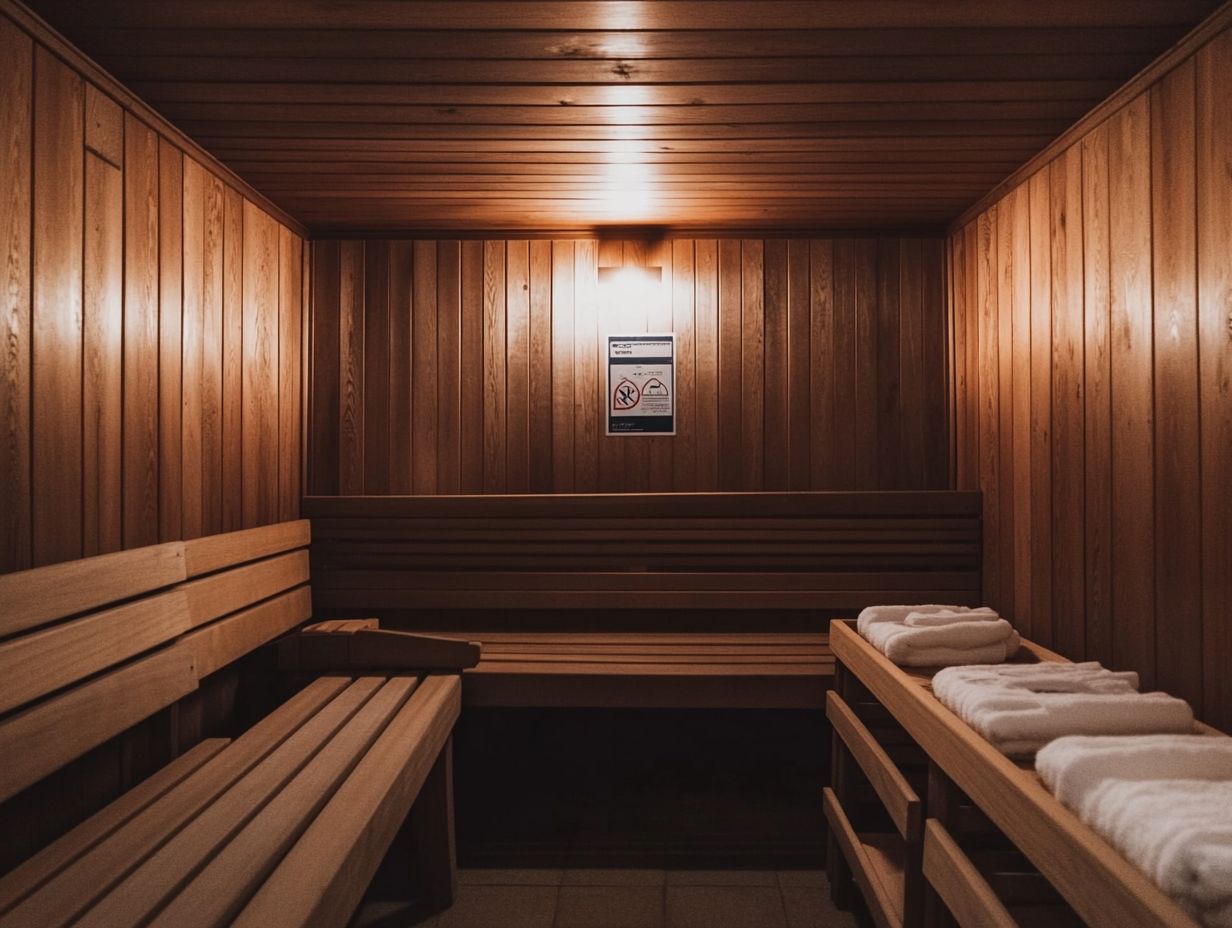
Want to enjoy your sauna safely? Here are some must-follow tips! Staying safe requires a few essential practices like maintaining appropriate temperature controls and proper hydration. Hydration is key, along with understanding temperature controls and recognizing your limits to avoid overheating.
Keep an eye on your water intake before and after using the sauna. Staying well-hydrated counters the fluid loss from sweating. Adjust the sauna temperature to a comfortable level to prevent overheating. Aim to limit your sessions to about 15-20 minutes based on your tolerance.
Be attentive to any signs of distress, such as dizziness or nausea. These may indicate it’s time to exit the sauna, especially if you’re sweating excessively. After your session, take a moment to cool down. This helps prevent shock and supports your recovery.
Sauna Safety for Children and Elderly
In terms of sauna safety for children and the elderly, you must consider the different ways their bodies respond to heat and moisture. This highlights the importance of tailored guidelines and sauna recommendations to ensure their well-being during sauna sessions.
Prioritizing their safety is essential for a comfortable and enjoyable experience.
Special Considerations for Vulnerable Populations
When considering sauna use for vulnerable populations like children and the elderly, it s crucial to take special precautions for their health. For example, children might struggle to regulate their body temperature effectively, making them more prone to overheating while using the sauna. Limit their sauna sessions for a safer experience!
On the other hand, elderly individuals often face a heightened risk of heart problems, so it s essential to talk to a doctor first. Tailored recommendations for both groups include maintaining lower temperatures in the sauna and ensuring proper supervision. Keeping an eye on their reactions to heat can help you prevent any adverse effects.
Creating a supportive environment that respects sauna etiquette will lead to a safer and more enjoyable sauna experience for these sensitive individuals.
Frequently Asked Questions
What are sauna safety policies?
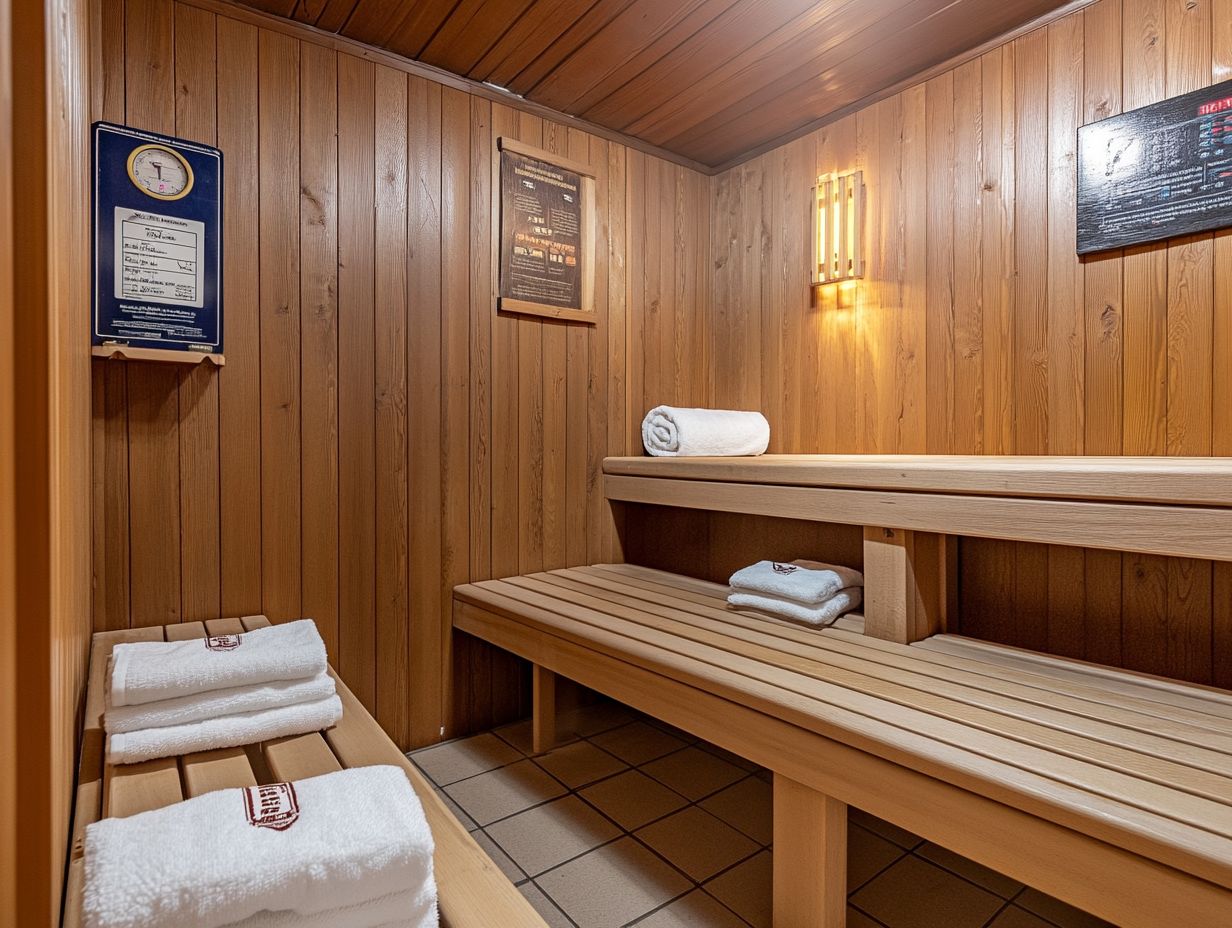
Sauna safety policies refer to guidelines and rules put in place to ensure the safe and proper use of saunas, including facility-specific guidelines and personal safety precautions. These policies aim to prevent accidents and promote a safe and enjoyable sauna experience for all users, while also enhancing their overall health benefits.
Why is it important to understand sauna safety policies?
Understanding sauna safety policies is crucial as it helps to prevent accidents, injuries, and mishaps. It also ensures that everyone using the saunas is aware of the rules and guidelines for their own safety and the safety of others, particularly regarding sauna etiquette.
What are some common sauna safety policies?
Some common sauna safety policies include limiting your sauna session to just 15-20 minutes, not using the sauna while under the influence of alcohol or drugs, and showering before and after using the sauna to prevent overheating. Additionally, users should be aware of the sauna temperature and hydration to avoid dehydration during their sauna sessions.
Can sauna safety policies vary from place to place?
Yes, sauna safety policies can vary from place to place. Some may have stricter policies in place, such as requiring users to be over a certain age or not allowing the use of saunas for pregnant women or people with certain health conditions, including those related to cardiovascular health.
What should I do if I notice someone not following sauna safety policies?
If you notice someone not following sauna safety policies, it is important to bring it to the attention of the sauna staff immediately. They will be able to address the situation and ensure that all users are following the necessary rules for a safe sauna experience, including understanding the importance of temperature controls and moisture levels in the sauna.
Are there any consequences for not following sauna safety policies?
Yes, there can be consequences for not following sauna safety policies. Some consequences may include being banned from using the sauna in the future or facing legal action if someone is injured due to negligence. Additionally, improper use of the sauna can lead to health risks, such as dehydration and cardiovascular disease.
Stay informed and enjoy a safe sauna experience!

